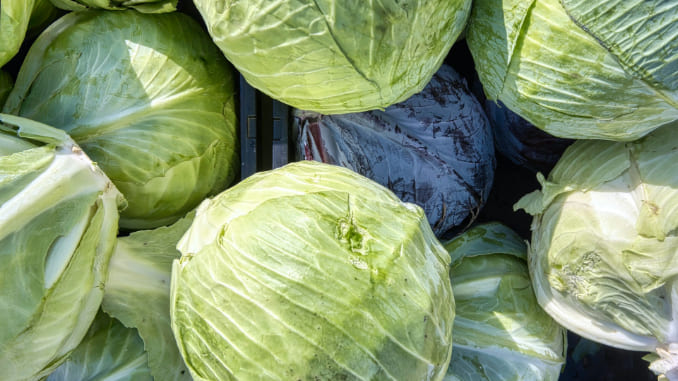
The transition from winter to warmer weather in the Northeast is glorious. As soon as the first warm day of the year arrives, shorts-clad families congregate at parks, girls in breezy dresses walk their dogs past blooming flowers, restaurant patios on city streets explode with bustling activity. These first warm days of the year signal that fresh summer produce—cherries, blueberries, tomatoes—will soon appear at farmers’ markets, plumper and more fragrant than the year-round varieties you can find at the grocery store.
But as soon as those jewel-toned fruits and veggies start to hit the market stands, we forget about the vegetables that got us through the winter, that we braised for the holidays and added to soups on dreary February afternoons. The cabbage, king of the cruciferous vegetables, often falls by the wayside in favor of fresh green lettuce when the weather starts getting warmer. Sure, cabbage is a staple in the winter months, but it can also be grown as a summer vegetable. And if you’re a fan of cheap, healthy, flavorful foods, then it’s one of the best things you can eat—both in the depths of winter and on the hottest day of the year.
While many of us think of cabbage as a dish that has to be cooked before it can be consumed, that’s not the case at all. Cabbage can be at its most delicious when it’s eaten fresh, raw and shaved into salads. Coleslaw, of course, is a great example, but don’t assume that you need to douse your raw cabbage in mayonnaise to make it palatable; it’s beautiful with lighter, olive-oil based dressings, and it can even be consumed all on its own without dressing if you really want to capitalize on the veggie’s signature crunch and bitter flavor.
If you do decide to cook your cabbage, though, grilling is a great method for the warmer months of the year, particularly if you already have a fire going to cook whatever else you’re having for dinner. Grilling cabbage gives it a nice, smoky char and can draw out its sweeter, more complex notes. You’ll want to cut the cabbage into wedges, making sure to keep the core intact. This way, the cabbage won’t fall apart on the grill on the grill, and you won’t have to worry about individual leaves burning to a crisp.
And if you don’t feel like firing up the grill, no worries. You can give simple sauteed cabbage a fresher flavor by adding lemon, garlic and bright herbs like dill. If you don’t have any lemon on hand, vinegar can also give fat-drenched cabbage a touch of much-needed acidity.
Don’t forget to experiment with a variety of different types of cabbage. Green cabbage is delicious raw and in salads, and it really shines when it’s pickled. Savoy cabbage has a milder flavor than the green variety, and it also offers crinkly leaves that can add incredible texture to a dish. Napa cabbage is extra-crunchy, and it shines in stir frys but can also be eaten raw and even cooked on the grill. And red cabbage tastes like an entirely different vegetable, with its intensely peppery flavor and deeply crunchy texture. That peppery note is especially noticeable when it’s consumed raw, but cooking mellows it out a bit.
As the seasons change, it’s time to embrace the flavors of the spring and summer, but that doesn’t mean you have to leave the old standbys behind. If there’s any vegetable you should be eating year-round, it’s cabbage.
Samantha Maxwell is a food writer and editor based in Boston. Follow her on Twitter at @samseating.